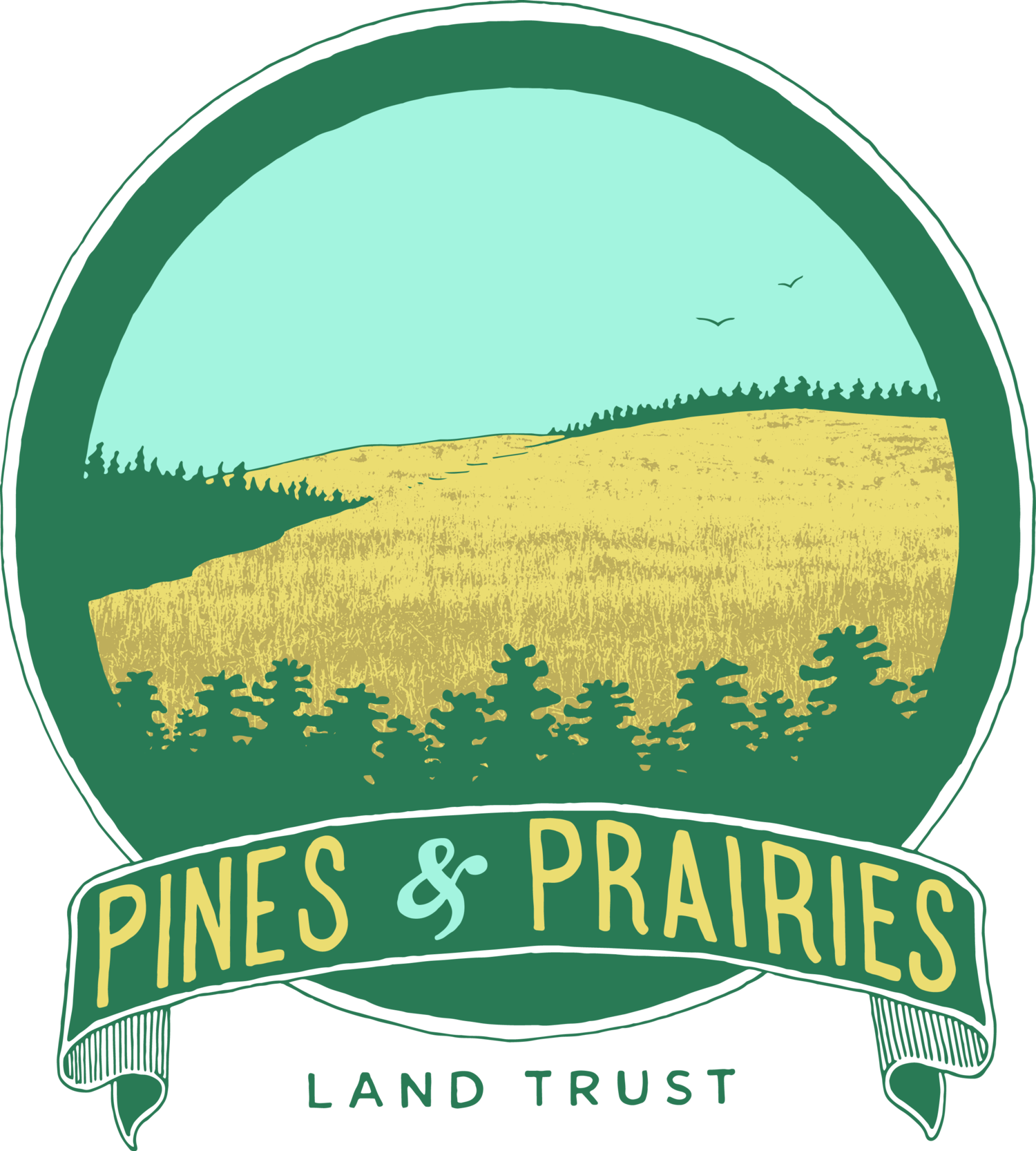by Larry Gfeller
Albert Pecore did not get where he is today by fortuitous accident; he nurtures a 196 acre spread on choice Fayette County ranchland, rich in native pastures, water features and a prime example of nature’s munificence. Hidden away in this natural wonder is a farm house like no other. . .starched white, multi-leveled, immaculate and uniquely his own design. You see, Albert is a man of vision—a retired architect. Over the decades he and his wife Wilda have carefully planned and sculpted the property to be as free and natural as it once was over a century ago—before the plows and cash crops and over-grazed plunder that so often robs our land of its natural wealth. Central to those plans is a timeless conservation easement through Pines and Prairies Land Trust; on this chilly December day, it was time for the annual site monitoring visit.
David Vogel and Cristin Embree are the PPLT board members conducting this visit; we start by climbing two flights of outside steps to the upstairs living room. First David catches up on recent history. . .what has been accomplished since last year’s visit (as a member of the PPLT Land Committee, David has conducted each monitoring visit from the beginning). Then Cristin, a professional archeologist, inquires about the old foundation she noticed not far from the house (remnants of the Emil Schlabach homestead), pointing out that it appeared on her map as an historic feature. She notes it can be protected by a preservation easement, if the Pecores decide to add it, and she urges them to consider it. Preservation easements are conservation easements that protect properties that have historic, architectural, or archeological significance. Preserving the past helps define the present, a truism Albert already appreciates.
Before departing to examine the property, Wilda provides a tour of their unusual home, stopping first to tenderly set a vinyl record on an antique record player—warm, joyful Christmas music fills the house. The home stands two stories tall with living areas interconnected by windowed hallways and internal stairs on the south end; from the side view, it evokes the letter “H.” A majority of the living space, be it elevated or ground floor, opens to spacious verandas overlooking the property to the east and west. On the upper east-facing portico stands a spotting scope on a tripod—Albert is intrigued by hawks. The home is clearly a labor of love that can only be described as singular and refined. He designed and partially built it himself.
We are accompanied by the family dog, Macy, a bouncy, playful spirit of energy.
On the ground level, there is a completely self-contained apartment—perfect for visiting guests and family. Across a stone patio on the east side lies another separate living space, complete with washer/dryer, bathroom, kitchen and generous windows. Macy is not allowed in this room; it is permanent refuge for Charlie and Shelby Texas (two lounging felines)—the family cats. It will not be Macy’s only disappointment of the day.
We gather by the barn and prepare to tour the property. Everyone piles into Albert’s 4-wheel drive Kawasaki, making it look like one of those third-world busses—packed in and over peopled. This is when Macy insists she also can fit, only to be disillusioned. She is so eager to go she has to be removed several times. At the final call, she is restrained on a stationary leash. . .as we pull away, she emotes a sorrowful look, as if considering her own bill of divorce.
Albert is an engaged and fervent guide, “I stopped making hay on this property fifteen years ago.” With a steady hand, he steers us around obstacles and through the savannah. As we negotiate the sprawling acreage, the conservation value of the land becomes apparent. . .an immense man-made pond, a section of riparian habitat and 38 acres of coppery native little bluestem singing in the December wind, part of which was recently restored. There are traditional intruders, like king ranch bluestem, johnsongrass and yaupon, but the native grasses dominate, summoning visions of sweeping blackland prairie, natural and undisturbed.
In the distance, you can almost see the buffalo graze.
Albert has invested significant effort in learning his grasses, pointing out indiangrass, little bluestem, switchgrass, plains bristlegrass, prairie wildrye and eastern gammagrass as we roll along. He’s particularly fond of new discoveries of big bluestem, stopping to cut samples for closer study. He has even begun his own native grass nursery, transplanting specimens he has picked up along roadsides, ditches and easements. Albert has put down chicken wire to protect the tender roots from encroaching armadillos. The nursery appears to be thriving, even during the dormant season.
Ever the gracious hostess, Wilda is our official gatekeeper today. As we snake our way around, she opens and closes the substantial gates that protect each parcel of property (there are sixteen separate permanent pastures). As we methodically run each fence line, Albert points out his efforts to plant native grasses where they don’t occur in sufficient abundance. “With the help and expertise of the Wildlife Habitat Federation a blend of native grass seeds were drilled into pastures in need of rejuvenation,” he exclaimed. The work is year round: if not planting or transplanting grasses or maintaining a pristine fence line, he keeps a regimen of planting cool season rye and legumes in pastures that have not been converted to native grass. Albert and Wilda do this work without outside assistance.
Aside from his delight in native grasses, Albert is busy with other aspects of good stewardship. As we lurch and roll along, he points out brush piles and cut cedar—one job he does contract out—keeping some to benefit wildlife, burning others. He has introduced native pecan trees, closely monitors rainfall amounts, watches changes in the water table, manages erosion, and runs a small herd of cattle. Having tried just about every method once, Albert believes in “pulse grazing.” Instead of dispersing his small herd broadly over the property, he intensely grazes different sections, moving the animals frequently—just like the buffalo did.
During a private moment, while getting a closer look at his riparian area, I ask Albert why he is doing all this.
“After purchasing the property in the 1950s, I never did intend to farm. I started with cattle and a riparianeasement. I bet most of the farmers in Fayette County have never put pencil to paper regarding riparian easements. The federal government pays me $50 per acre per year. That nets out to probably be better than many farmers do running small herds or growing small cash crops,” he explains. Albert has three sons. He discussed entering his property into an over- arching perpetual conservation easement with all of them beforehand. They heartily agreed—preserving and protecting the land was important to them too.
“How has it been, working with Pines and Prairies Land Trust,” I asked him.
“It’s been a good experience,” he replied. “I signed up with PPLT in 2007. . .we’ve been learning together ever since.”
So David made his notes, complemented the Percores on their efforts and thanked them for their hospitality. Macy had already forgotten her earlier disappointments. Shortly, we were loaded up and ready to go.
In three hours we had witnessed what happens when man and nature cooperate. It used to be a mutual necessity, when the land provided life itself. Now, in this age of smart phones, Internet and international marketing agreements, technology has set us free and blurred our primordial connection with the land. The majority of Texas is privately owned. Although our relationship with the land may have changed, the truth has not. We still need each other. Only through enlightened landowners—like the Pecores—can we restore this vital connection.











